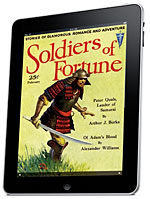A lot of the stories and novels I like to read are ephemeral. Literally.

I’m afraid of spending too much time holding my pulp magazines for fear they will turn to dust in my hands. They range from 55- to 114-years-old, and they are disappearing sliver by sliver. So I rarely open them up to read.
Is it worth paying $20, $50, $150 or, sometimes, much, much more for a pulpwood paper magazine that may not be around much longer? You seal them in a mylar bag and put them on the shelf, afraid to do much more than pick them up to look at the fade cover that once was vivid in its yellows, reds and blues.
I keep thinking about the quote attributed to publisher Frank Munsey: “The story is worth more than the paper it is printed on.”
Are the stories what you collect or the containers of the stories, the pulp magazines themselves?
Clearly there’s a market for printed pulp reproductions. Girasol Collectibles, Age of Aces, Sanctum Books, Wildcat Books, Altus Press and others are regularly producing pulp facsimiles or reprints.
But I’m thinking about just the stories and artwork alone. In e-book form.
The crew over on the Yahoo Group, Pulp Scans, have been scanning pulps and microfilm of pulps for several years now and have accumulated quite a selection of vintage fiction.
“Three years ago I started the Pulp Scans group,” Dave Reeder says, “and have been incredibly fortunate in attracting a number of dedicated pulp scanners, keen to preserve our heritage. I haven’t kept count, but I think we’ve shared around 350 pulps so far, from early saucy titles to mainstream science fiction to western. The hero pulps we’ve stayed away from after a wake-up mail from Conde Nast’s lawyers!”
Reeder says the group focuses on pulps that aren’t being reprinted, so as not to compete with reprint publishers.
“In a sense, I see our role as cultural archivists,” Reeder explains. “If this material is lost then nobody will ever be able to reprint it commercially. Plus it’s great to read! …”
“The past crumbles. Digital preserves and shares. I guess it’s as simple as that,” Reeder says.
Is this the future of pulp collecting? As much as a lot of us are loath to admit, it probably is.
What if the cover of your pulp was vibrant? The text and interior illustrations a solid black on crispy white? What if you could tap twice to zoom in to make the story more legible? And you could carry your entire pulp collection around with you in your Apple iPad or other digital reader, without worrying about it crumbling to bits?
For me, the concept is getting more and more likable.
– William



A few points….
It’s true that reprint publishers have sprung up like weeds. We can thank the development of desktop-publishing software and the proliferation of Print-On-Demand companies for that. As I’ve said for several years now, we’re living through the Golden Age of Pulp Reprints, and to the extent that the fiction is reaching new fans who can’t or won’t collect the old magazines, that’s a good thing.
To me, personally, the availability of reprint pulp fiction accessed solely via digital means doesn’t count for a whole lot. I’m not interested in reading long stories on electronic gizmos. I’m a book person; I want hard copy.
I’d hate to see a devaluing or diminution of the hobby’s collecting component. You guys who love downloading pulp stories for free and reading them on iPads wouldn’t be enjoying the stuff if previous generations of collectors hadn’t already invested their valuable leisure time and hard-earned money tracking down, buying, and preserving the relatively few remaining copies of the pulps now being scanned for sites like Pulpgen. This stuff would all have been landfill decades ago were it not for the collectors who sought it out and reclaimed it from the dustbin of pop-culture obsolescence.
I often hear, as a justification for preferring hard-copy reprints and digital downloads, that “I’m afraid to read my pulps because they crumble every time I open them up.” With all due respect, that’s a bogus argument — unless you’ve been buying really, really ratty pulps. I own many hundred-year-old pulps, dime novels, and nickel weeklies that are practically as fresh today as they were when originally published. Even average-condition pulps are a lot less fragile than most people think. We know now that the chemical reaction which accelerates the acidification and deterioration of woodpulp paper wreaks its havoc within 30 to 50 years after publication. Pulps, dime novels, and comics that have survived this long are not likely to get a whole lot worse unless they’re improperly stored. So even run-of-the-mill G to VG copies are still in good enough shape to read. You might get the occasional flaking at the extremities, but pulps were notorious for “shedding” even when they were hot off the press. Unless you’ve got something that’s really brown and brittle, it should be readable with just a little careful handling.
I won’t get into the tactile pleasure one gets from handling vintage pulps; suffice to say that most veteran collectors agree that reading from the actual magazines — as opposed to reprints — enhances the experience in a way that’s difficult to describe or quantify.
Anyway, that’s how I feel. Would love to hear from others.
Ed has stated his position so well that anything I have to say will be redundant.
I agree with Ed that I have zero interest in reading from any sort of electronic “gizmo”. Especially at any length.
I also agree with Ed that the argument that pulp magazines disintegrate with as little as a harsh look has been overstated more than a little. Like Ed I have pulp magazines that are 80 years old and they have not fallen apart.
As a collector I feel a connection with the real thing that is impossible with a facsimle reprint. That is not to say that I do not own some, just that they do not have the same emotion attached to them that the originals do. I have friends that are readers that can’t understand why I love a first edition hardcover when a cheap pb reprint has the same story but they miss the point.
I definitely agree with Ed Hulse and Barry Traylor. I’ve been collecting pulps since the 1960’s and read them all the time, including magazines a hundred years or older, such as ADVENTURE and ALL STORY. They are not falling apart or disappearing before my eyes. I buy many of the pulp reprint volumes but I just do not care for reading fiction online or on electronic readers.
It is still possible to buy the original pulp magazines without getting a bank loan or filing for bankruptcy. I’m talking about collecting the western and general fiction titles, such as WESTERN STORY, ARGOSY, BLUE BOOK, SHORT STORIES, ADVENTURE. You can get a 100,000 words of good fiction in each issue, written by professional writers who know how to write entertaining stories, for a reasonable $10.00 to $20.00. Sometimes even less.
Maybe bidding on ebay might get pricey but if you attend the Windy City Pulp show(April 23-25) in Chicago or PulpFest(July 30-Aug 1) in Columbus, Ohio, then you will find around a hundred tables crammed with pulps. Many will be priced at very reasonable prices and they won’t fall apart when read.
Maybe I made my point a little too harshly. I really wasn’t pooh-poohing the idea of collecting actual pulps. I completely appreciate holding an original pulp, thumbing through it and reading it (and smelling the musty pulpwood, too).
But we need to start thinking about the long-term future of the pulps. There are only a limited number of pulps left and they aren’t making any more. What’s to become of the fiction once the magazines are gone?
I’ve been thinking about this topic for a number of years now. So it will be coming up again!